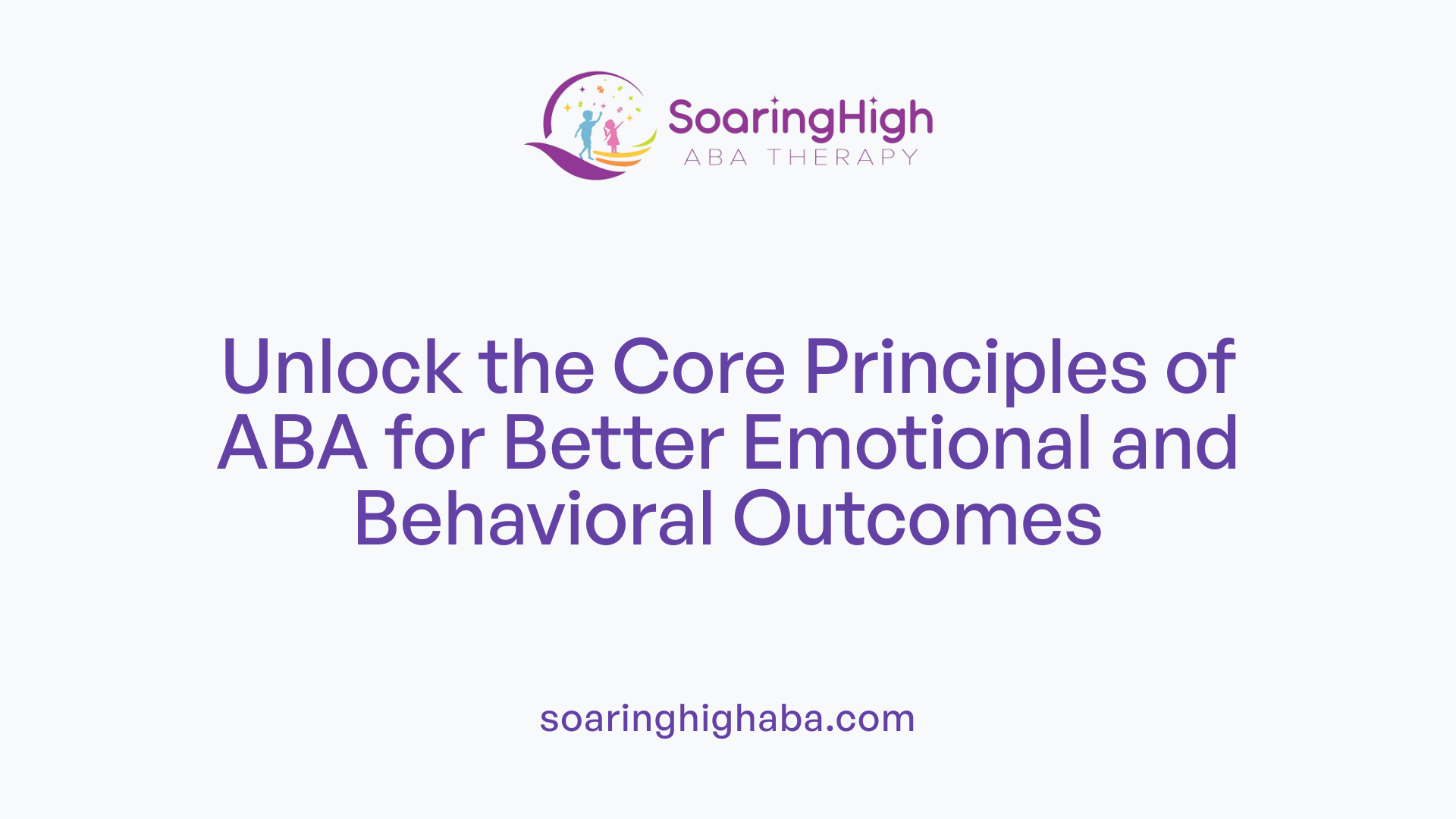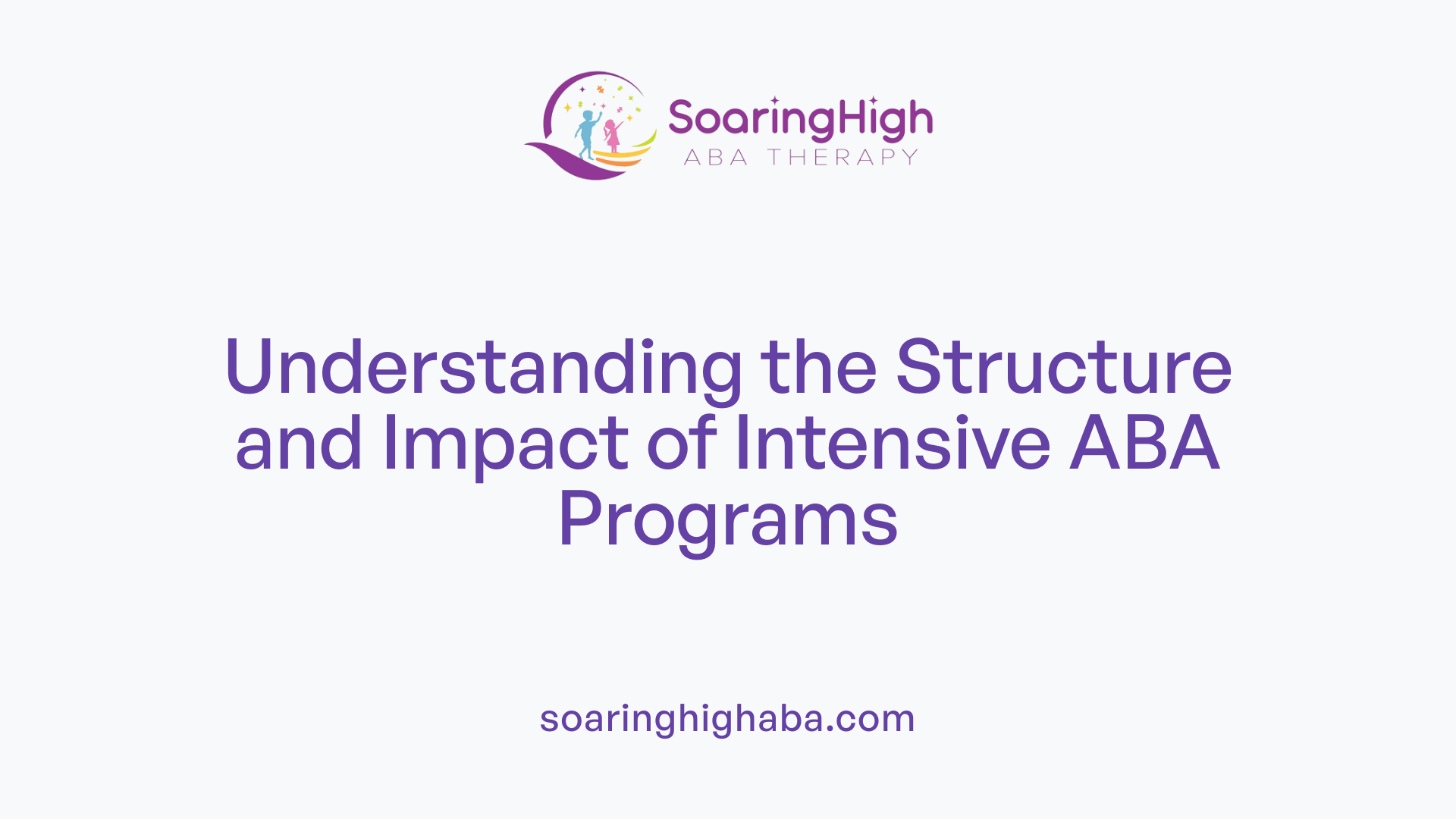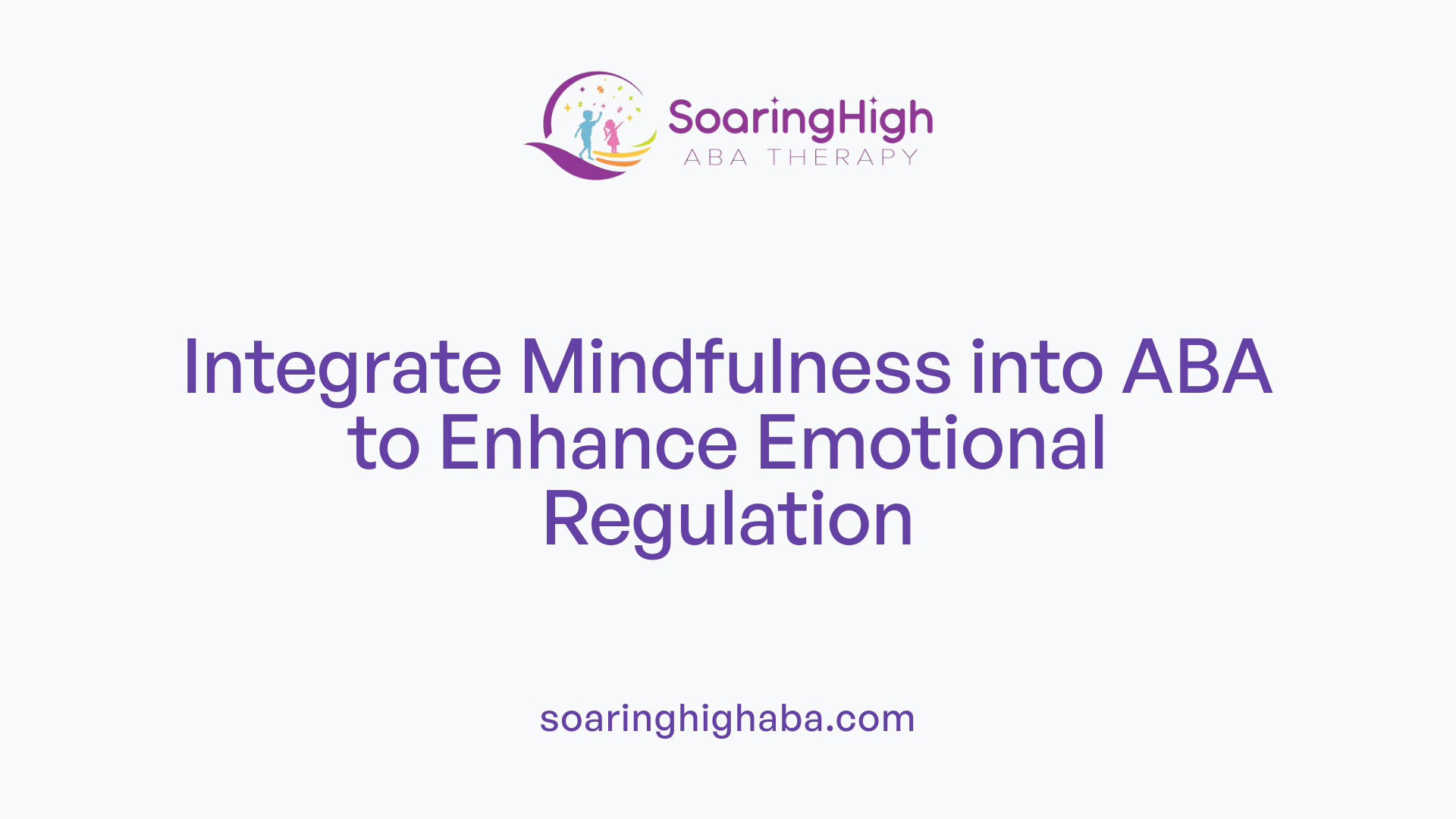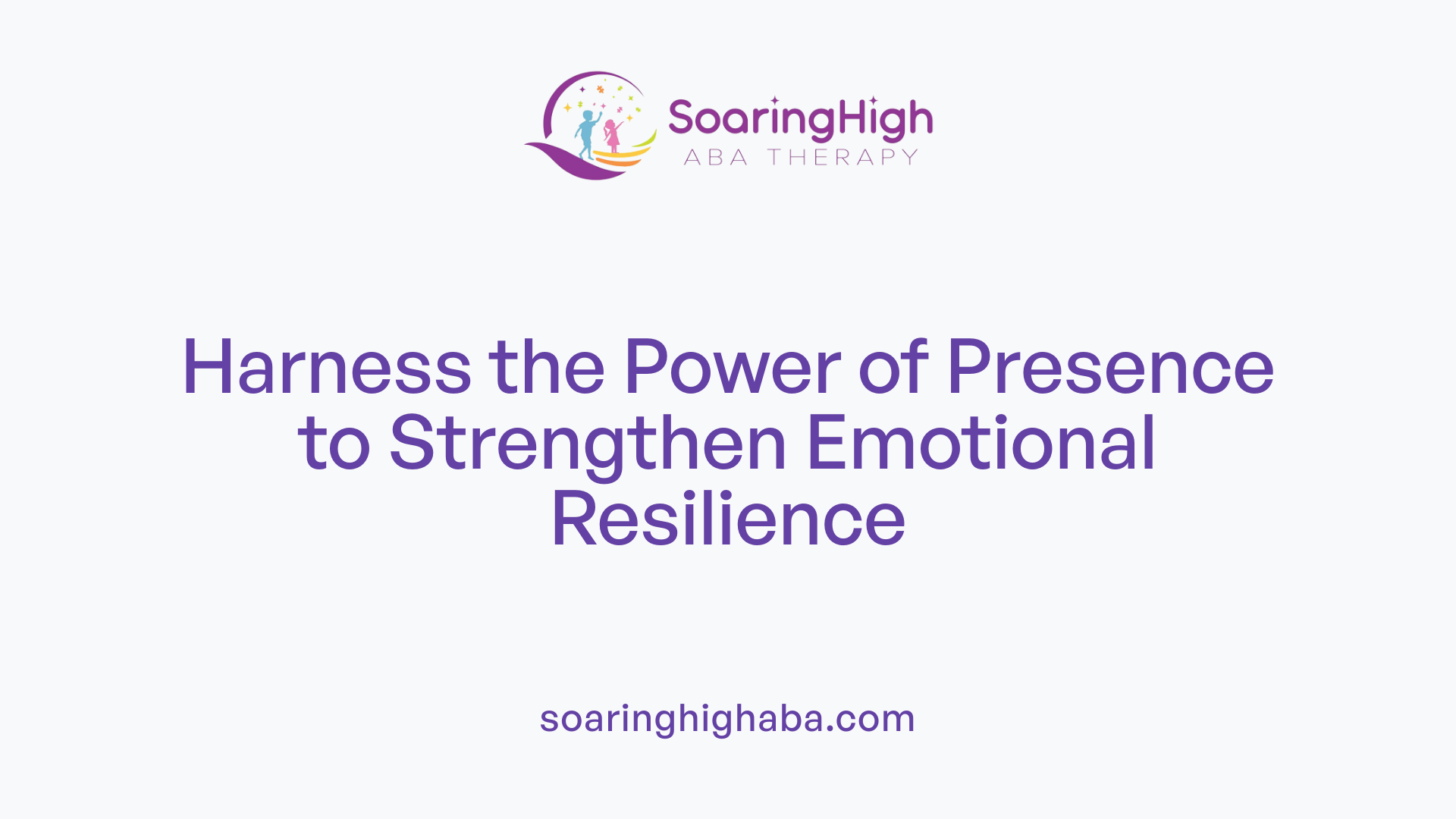Unlocking Resilience with Evidence-Based Methods
In recent years, the importance of emotional resilience has gained recognition for its role in mental health and overall well-being. Applied Behavior Analysis (ABA), traditionally associated with autism spectrum disorder (ASD) treatment, has emerged as a powerful approach not only for behavioral development but also for fostering emotional resilience. This article explores the multifaceted role of ABA in teaching emotional resilience, combining behavioral strategies with the promotion of presence and mindfulness to empower individuals to navigate life's challenges more effectively.
Understanding ABA and Its Core Principles

What is the role of ABA in teaching emotional resilience?
Applied Behavior Analysis (ABA) plays an important role in teaching emotional resilience, particularly for children with autism and other developmental differences. By systematically shaping behaviors and emotional responses, ABA helps individuals learn how to cope with challenging emotions and develop resilience.
ABA uses reinforcement strategies to encourage positive behaviors and emotional regulation. For example, therapists may reward a child for managing frustration or practicing patience, which reinforces these adaptive behaviors.
Incorporating resilience training into ABA often involves teaching mindfulness, gratitude, and body-awareness exercises. These practices help clients stay grounded and develop a greater capacity to handle difficult emotions.
Neuroscientific research supports that fostering presence—a focused awareness of the present moment—can improve emotional regulation. This is achieved through techniques like breathing exercises, body sensation observation, and yogic practices such as pranayama.
By combining behavioral interventions with activities that promote presence, ABA not only helps modify observable behaviors but also strengthens the neural pathways linked to emotional resilience. Overall, ABA supports the development of strong psychological resources, equipping individuals to face life's emotional challenges with greater confidence and stability.
The Intensive Nature of ABA Therapy and Its Efficacy

What is the typical structure and duration of ABA sessions?
Applied Behavior Analysis (ABA) therapy is known for its intensive approach. Sessions usually range from several hours daily, often averaging between 20 to 40 hours per week. These sessions are conducted multiple times each week and can last for two or more years, depending on the child's needs and progress.
The therapy involves systematic, step-by-step assessment and reinforcement of desired behaviors. Therapists focus on observing antecedents, behaviors, and consequences, creating a structured environment where each small achievement is reinforced to promote ongoing development.
What are the goals of ABA in fostering independence and reducing interventions?
The primary aim of ABA is to support children with autism spectrum disorder (ASD) in achieving greater independence. This includes improving communication skills, social interactions, and daily habits that enable them to function more autonomously.
Over time, ABA strives to reduce the reliance on external support services by helping children develop self-management skills. The therapy’s structured reinforcement strategies help embed these skills deeply, making it easier for children to navigate daily life with confidence.
Why is early intervention important?
Research shows that starting ABA therapy early—around age 3—maximizes its effectiveness. Early intervention tends to result in more significant improvements in social, communication, and adaptive skills.
Optimal results are often seen with 20 to 40 hours of therapy weekly over at least two years. Early and intensive intervention can set a foundation for lifelong skills and help reduce the severity of challenges faced later in life.
| Aspect | Details | Additional Notes |
|---|---|---|
| Session Length | Several hours each session | Usually 20-40 hours per week |
| Duration | Typically at least 2 years | Extended periods ensure skill mastery |
| Focus Areas | Social skills, communication, daily routines | Tailored to individual needs |
| Goal | Promoting independence | Preparing for autonomous living |
How effective is ABA in developing emotional resilience?
Applied Behavior Analysis (ABA) is highly effective for building emotional resilience, especially when tailored to each individual. It helps individuals learn emotional regulation, social skills, and healthy coping mechanisms. Techniques like positive reinforcement and systematic behavior breakdowns allow clients to identify and modify reactions to various emotions.
Family involvement and consistent reinforcement are vital in generalizing these skills for everyday use. As a result, many clients become better equipped to manage difficult feelings and adapt to stressful situations, ultimately leading to improved emotional resilience.
The Critical Role of Early Intervention
Why is ABA important in emotional and behavioral development?
Applied Behavior Analysis (ABA) plays a vital role in shaping emotional and behavioral growth, especially in children with autism spectrum disorder (ASD). It is grounded in evidence-based strategies that teach essential skills such as communication, social interaction, and emotional regulation. Through detailed analysis of antecedents, behaviors, and consequences, ABA creates tailored intervention plans that foster positive emotional responses and promote adaptive behaviors.
ABA employs various techniques such as positive reinforcement, visual supports, social stories, and role-playing. These methods help children understand and manage their emotions better, supporting improvements in self-regulation and social skills. Because the brain exhibits significant plasticity during early childhood, starting ABA interventions around age 3 can lead to more durable, meaningful improvements.
Intensive ABA therapy—typically involving 20 to 40 hours per week—maximizes these developmental gains. Such early and consistent intervention takes advantage of critical periods in brain development, enabling children with ASD to develop stronger emotional awareness, better social competence, and more independent behaviors. Over time, these benefits can last well into adolescence and adulthood, making early intervention not only crucial for immediate progress but also for long-term emotional and social well-being.
| Aspect | Details | Additional Notes |
|---|---|---|
| Timing of intervention | Around age 3 for optimal brain plasticity | Early intervention boosts learning and emotional growth |
| Intensity of therapy | 20-40 hours weekly, lasting at least two years | Ensures consistent progress and skill mastery |
| Long-term benefits | Improved social skills, independence, emotional regulation | Sets the foundation for lifelong adaptive behaviors |
Fostering emotional resilience and behavioral independence through early, intensive ABA remains a cornerstone in supporting children with autism, helping them navigate the complexities of emotional growth while building a foundation for a more adaptive future.
Techniques and Strategies in ABA
Applied Behavior Analysis (ABA) uses a variety of methods to promote emotional resilience and social development. Central to ABA is the use of positive reinforcement, where desirable behaviors are rewarded to encourage their repetition. This approach helps individuals learn new skills and build confidence in their abilities.
Another foundational strategy is the systematic breakdown of complex behaviors into smaller, manageable steps. This skill acquisition process allows children to gradually master tasks and social interactions, fostering independence and self-efficacy.
ABA also involves careful assessment of antecedents, behaviors, and consequences—an approach known as the ABC model. By analyzing what triggers behaviors and the outcomes that follow, therapists can design more effective interventions tailored to each child's needs.
In addition to typical behavioral targets, ABA focuses on social skills training. This includes teaching communication, cooperation, and emotional regulation, which are essential for resilience. Through repeated practice and reinforcement, children learn to manage their emotions better and respond adaptively to challenges.
Overall, ABA's structured, evidence-based techniques support emotional resilience by helping individuals develop positive habits, social connectivity, and coping strategies. This personalized approach, combined with continuous progress monitoring, ensures that therapy remains responsive and effective as children grow and change.
Fostering Presence and Mindfulness through ABA

Why is presence important for emotional regulation?
Presence involves maintaining focused, sustained attention on the current moment with active reflection and awareness. This grounded state can help individuals better tolerate and short-circuit intense emotions, thus supporting emotional regulation. The ability to stay present allows clients to observe their feelings without immediate reaction, fostering resilience and emotional balance.
In therapy, developing presence is especially valuable. It can help clients experience difficult emotions with less overwhelm and greater clarity. For children with autism or trauma survivors, cultivating presence can lead to improved tolerance for emotional discomfort and reduce behaviors linked to dysregulation.
What methods can help induce presence?
Various practical techniques are effective in fostering a state of presence. These include mindfulness exercises, such as paying close attention to bodily sensations or observing breath patterns.
Body awareness practices, like noticing tension or relaxation in specific areas, help anchor individuals to the present moment. Breathing techniques, particularly yogic methods like pranayama or mantra meditation, are also powerful in modulating the nervous system.
An easy-to-remember tool is the P-R-E-S-E-N-C-E acronym, which guides clients to Pause, Reflect, Observe, Notice, Center, Engage, and stay in the present. Incorporating regular time for body scanning, mindful breathing, or gentle movement enhances the ability to stay grounded.
How does neuroscience support the practice of presence?
Research shows that being present triggers positive changes in brain activity. Increased alpha and theta waves, associated with relaxation and meditative states, promote calmness. Additionally, presence reduces activation of the autonomic nervous system, which is involved in stress responses.
Neuroscience indicates that intentional engagement in presence activates certain brain regions—including the dorsolateral pre-frontal cortex, Default Mode Network, and Salience Network—that help regulate emotions and decrease distress.
Moreover, modulating activity in the amygdala, the brain's fear center, reduces anxiety and promotes feelings of safety. This neural shift explains why mindfulness and presence practices can lessen emotional reactivity and foster emotional resilience.
Practical application in ABA
In ABA, therapists can integrate presence-inducing techniques to augment behavioral interventions. For example, incorporating mindfulness exercises into routines, helping children observe their bodily sensations or practice deep breathing, can improve emotional regulation.
Studies and case examples show how fostering presence helps clients like Lin, who struggles with trauma and anxiety, increase their tolerance for difficult feelings. Therapists’ own mindful presence and attunement during sessions also enhance trust and treatment efficacy.
By combining behavioral strategies with established mindfulness and somatic practices, ABA can support emotional resilience and overall well-being.
| Techniques | Description | Benefits |
|---|---|---|
| Mindfulness exercises | Paying attention to thoughts, sensations | Reduces stress, improves focus, enhances calm |
| Body sensation observation | Noticing tension or relaxation in the body | Increases body awareness, promotes grounding |
| Breathing techniques (Pranayama) | Regulated, mindful breathing | Aids nervous system regulation, calms mind |
| Presence acronym P-R-E-S-E-N-C-E | Systematic focus on current moment | Builds habit of mindfulness in daily life |
This holistic approach, blending ABA with mindfulness and somatic awareness, offers a powerful pathway to fostering resilience and emotional regulation in clients.
The Neuroscience of Presence and Emotional Resilience

How does brainwave activity change with presence?
Research in neuroscience shows that being present can alter brainwave patterns, especially increasing alpha and theta waves. Alpha waves are associated with a state of relaxed alertness, calmness, and mental clarity, helping individuals remain centered amidst stress. Theta waves, on the other hand, are linked to deep relaxation, meditation, and the processing of emotional content. These shifts in brain activity support a calm internal environment that fosters emotional resilience.
What is the impact of presence on the autonomic nervous system?
Practicing presence has been shown to reduce activity in the autonomic nervous system, which controls involuntary bodily functions like heart rate, blood pressure, and respiration. By decreasing sympathetic nervous system activation, presence helps lower stress levels and promotes a sense of calm. This reduction in physiological stress responses can improve overall resilience, enabling individuals to better tolerate difficult emotions and stressful situations.
How does presence influence the amygdala?
The amygdala plays a central role in processing fear and emotional reactions. Neuroscience suggests that cultivating presence can modulate the activity of the amygdala, leading to decreased hyperreactivity. This modulation fosters emotional regulation by preventing overwhelming emotional responses, such as anxiety or panic. Consequently, individuals who develop a stronger ability to be present tend to handle emotional challenges more effectively.
| Neural and Biochemical Changes | Description | Impact on Resilience |
|---|---|---|
| Increased alpha and theta wave activity | Enhances calmness and emotional processing | Promotes emotional stability |
| Reduction in autonomic nervous system activity | Lowers physiological stress response | Decreases anxiety, improves resilience |
| Modulation of the amygdala | Damps hyperreactivity to stress | Strengthens emotional control |
Approaches to cultivate presence for resilience
Various techniques help induce a state of presence, including mindfulness exercises, body sensation awareness, breathing practices like pranayama, and mantra meditation. These methods activate the neural pathways associated with calmness and emotional regulation, building resilience over time.
In summary, neuroscience reveals that consistent practice of presence can produce measurable changes in the brain's activity, which in turn enhances emotional resilience. By fostering calm neural states and reducing stress-related responses, individuals can better navigate life's challenges and maintain mental well-being.
Case Studies and Practical Applications in Therapy

How effective is ABA in developing emotional resilience?
Applied Behavior Analysis (ABA) has proved to be a highly effective method for fostering emotional resilience, especially when tailored to individual needs. Through its structured approach, ABA employs techniques like positive reinforcement to encourage desired behaviors and reduce maladaptive responses.
In practice, ABA helps individuals develop essential skills such as emotional regulation, social interaction, and coping strategies. By breaking complex behaviors into manageable steps, therapists guide clients toward learning adaptive responses in everyday situations.
Family involvement is a crucial aspect. When caregivers reinforce learned skills consistently, these behaviors become more ingrained, allowing clients to generalize their new competencies beyond therapy sessions.
Real-life examples of resilience training
For example, a child with autism exhibiting difficulty managing frustration might undergo ABA to learn calming techniques. Over several months, with reinforcement, they can respond to stressors more adaptively, reducing tantrums and increasing their emotional flexibility.
Similarly, adolescents with trauma history can benefit from ABA's structured environment, gradually building resilience and confidence. These successful cases underline how behavioral strategies integrated with emotional skill-building can significantly improve life quality.
Behavior and mindfulness in therapy
Integrating mindfulness practices into ABA sessions enhances emotional awareness and presence, fundamental components of resilience. Techniques like observing body sensations, mindful breathing, or yoga-based breath control complement behavioral interventions by helping clients stay grounded and respond thoughtfully.
Therapists trained to incorporate presence—being fully attentive and reflective—allow clients to develop a deeper awareness of their emotional states. This combination of behavioral and mindfulness methods can accelerate emotional regulation and tolerance for difficult feelings.
Impact on trauma and anxiety
For clients with trauma or anxiety, the combination of ABA and mindfulness has shown promising results. These approaches support stabilization by teaching clients to recognize emotional triggers and respond with greater calmness.
Case studies highlight that fostering presence reduces hyperarousal and fear responses, leading to better emotional balance. Increased resilience fosters independence, allowing clients to navigate daily challenges with increased confidence.
| Aspect | Technique | Benefits | Example |
|---|---|---|---|
| Emotional resilience | ABA + Mindfulness | Improves regulation and tolerance | Helping trauma survivors face stress without overwhelm |
| Presence in therapy | Body observation, breath work, P-R-E-S-E-N-C-E exercises | Enhances grounded awareness | Clients managing anxiety through mindful breathing |
| Emotional skill-building | Reinforcement, systematic behavior breakdown | Develops adaptive responses | Children learning to cope with frustration |
These integrated methods demonstrate how combining behavioral science with mindfulness enhances therapy’s effectiveness in developing resilience, especially in trauma-related cases.
Enhancing Therapist-Client Connection Through Presence
Why is ABA important in emotional and behavioral development?
Applied Behavior Analysis (ABA) plays a crucial role in the growth of emotional and behavioral skills, especially for children with autism spectrum disorder. By focusing on observable behaviors and systematic reinforcement, ABA helps individuals develop better social interactions, communication, and emotional regulation.
Therapists trained in ABA carefully assess antecedents, behaviors, and consequences to design personalized strategies that foster positive responses. These include employing visual supports, social stories, and role-playing exercises that make complex social and emotional concepts more understandable.
Starting early—around age 3—with intensive therapy of 20 to 40 hours weekly, ABA leverages the brain's plasticity to promote lasting behavioral and emotional gains. Over time, children learn to manage their feelings and interact more effectively, leading to greater independence and improved quality of life.
In essence, ABA creates a structured pathway for children to grasp emotional cues, regulate their responses, and build meaningful social connections, laying a foundation for lifelong adaptive skills.
Future Perspectives: Integrating ABA and Mindfulness
As research continues to reveal the benefits of presence and mindfulness in emotional health, integrating these practices with ABA techniques offers promising avenues for enhancing emotional resilience. Therapists are now emphasizing their presence and attunement as foundational elements in therapy, recognizing their neural impact on emotional regulation. The intersection of ABA's structured behavioral strategies with the mindfulness-based focus on present awareness equips individuals with a comprehensive toolkit to manage stress, process trauma, and build resilience. Moving forward, combining behavioral interventions with neuroscience-informed mindfulness practices holds great potential for advancing emotional development and well-being across diverse populations.
References
- Find Autism Therapists and Psychologists in Myrtle Point, OR
- On the Therapeutic Power of Presence
- Applied Behavior Analysis (ABA)
- The effectiveness of applied behavior analysis program ...
- Find Autism Therapists and Psychologists in Myrtle Point, OR
- Resilience guide for parents and teachers
- 11 Life-Changing Benefits of ABA Therapy - Pillar5
- Everything that is there to know about ABA therapy
- The Vital Role of Applied Behavior Analysis in Child ...
- What is Emotional Regulation? Breaking Down the Basics ...





































































































